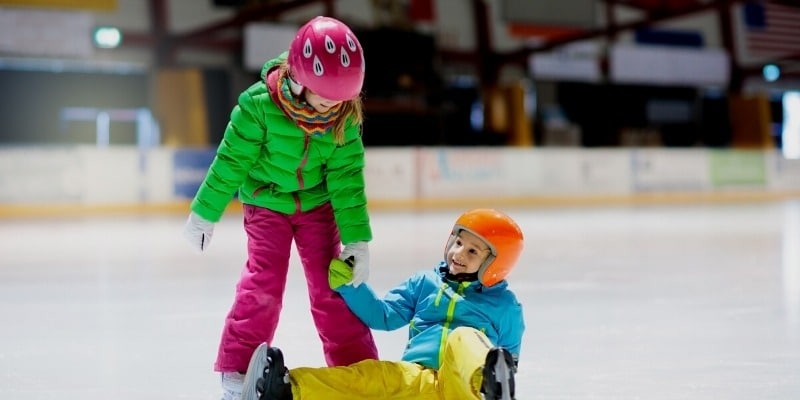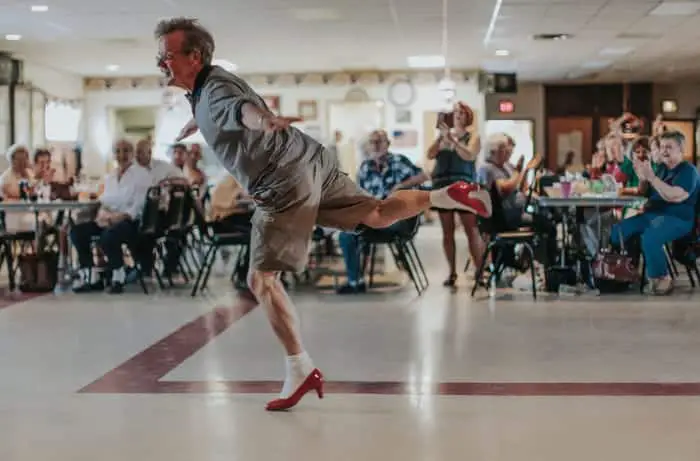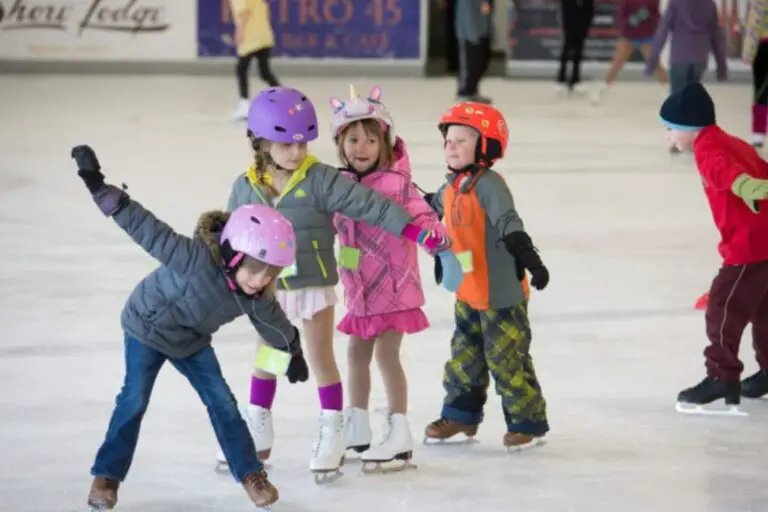Ice Skating Equipment List [16 Items with Recommendations]
( If you purchase through our sponsored links, we may receive a small commission at no extra cost to you )
In the winter, many people enjoy outdoor activities that include ice skates. Ice skating can be a lot of fun and a great way to get exercise.
Kids and adults alike love to take to the ice for a day of skating whether it is picturesque natural ice sheets or indoor skating rinks. But what does one need to skate? This Ice Skating Equipment list will show you the necessary items that will make the skating experience complete.
Equipment of Ice Skating
Here we have listed and described the 16 most important pieces of equipment needed for ice skating. Not only that but also check out why need to use any specific equipment and what type is perfect for ice skating.
- Ice Skates: Main Equipment; Top Pick: Jackson Ultima Excel Figure Ice Skates: Great Fit and Comfortable
- Skate Sharpener: To Sharpen the Skate; Top Pick: SPARX Skate Sharpener – Bundle: Perfect Edging and easy to use
- Pants/Tights: Need to be breathable and flexible; Top Pick: ChloeNoel Figure Skating Spiral Pants: Good Looking & Great Fit
- Laces: Get Thin and Flat Laces; Top Pick: Jackson Figure Skating Elite Laces: Polyester made, soft, narrow enough to fit well.
- Soakers: To protect and cover blades; Top Pick: CRS Cross Skate Soakers: Terry Fabric, absorbent towel, noe need of trimming.
- Unitards: Main Dress for Figure Skaters; Top Pick: Hansber Kids Girls Ballet Dance Gymnastics Unitard: Soft, quickly dry, stretchy, Comfort.
- Warmup Jackets: To warm you up; Top Pick: Victoria’s Challenge Warm Fleece Ice Skating Jacket: Soft inner surface, cool and warm, durable and cozy.
- Wrist Guards: To Protect your wrist; Top Pick: Flauto Wrist Guard: Impact resistant and breathable.
- Ice Skating Bag: To keep your ice skating equipment; Top Pick: Gonex Upgraded Skate Bag: Made of quality fabric, bigger and flexible
- Helmet: To keep your head safe from injury; Top Pick: OutdoorMaster Kelvin Ski Helmet: ABS shell, shock absorbent, safety and comfort.
- Elbow Pads: For elbow safety; Top Pick: ActiveWrap Elbow Pad: Soft stretchable fabric, well fit.
- Knee Pads
- Protective Glasses
- Water Bottle
- Ice Skating Rink

Ice Skates
Some of the most common types of ice skating skates are figure, hockey, speed, and recreational. Figure skates are typically more flexible than hockey skates, which are better for playing hockey. Speed skates are designed for racing on ice rinks or tracks with tighter turns. Recreational skates are perfect for beginners to learn how to ice skate before they move on to more advanced types of skating.
Ice skating can be done with two different types of skates. The first is the figure skating ice skate. This type has a blade that is much shorter than an ice hockey skate and is made for speed. The other type of skate is an ice hockey skate which has longer blades to give more stability on the ice. Hockey skates are made for gliding, turning, and stopping while figure skating skates are for speed and jumping.
Overall, if you look for a comfortable skate, don’t miss out on this article.
Skate Sharpener
Ice skating is fun, but it can be difficult when the ice is too thick. Skate sharpening is a way to keep ice in excellent condition for skaters. You may have noticed your skates are tough to move around in when the ice has gotten too thick.
When you use a skate sharpener, you’ll have an easier time moving across the surface of the ice.
A skate sharpener can help keep skates from becoming dull. When skates become dull, they are harder to control and will provide less of a skating experience.
Pants/Tights
When skating outdoors over the snow, one should make sure their pants are water-resistant and snowproof. However, when skating indoors on a rink, one should make sure their pants are reflective to help other skaters see them better at night. Also, the pants should not contract the legs and they should dry up quickly. Sweat pants, leggings or joggers could be a good option.
You can also wear tights of any type from ankle-high, calf-high, and ballet-length. Tights are important for protection against injuries. Compression tights are tight-fitting, supportive garments that are used for injury prevention and rehabilitation.
Soakers
Skate soakers are typically used by figure skaters to keep their blades dry while skating. They are often placed over the blade in order to push the water away from the blade, which in turn allows for a smooth, frictionless skate across the surface of the ice.
Skaters can use them in any number of ways depending on what they need at the time.
They are used in a variety of situations including choreographed routines, warm-up routines, and in figure-skating shows.
They can also be used to cool the blades when skating on an outdoor rink.
Unitards
Many ice skaters prefer to wear a unitard when they compete in an ice skating competition. A unitard will have a top and bottom part that is made of the same material.
There are many benefits to wearing a unitard, such as that it is comfortable, they allow you to move more freely, they keep you warm in cold temperatures, they can be worn under or over another garment, and you can easily adjust the tightness around your waist. Unitards can also be worn as a separate piece of clothing, such as a turtleneck.
Ice Skating Gloves
Ice skating is a sport that requires the use of skates to glide on ice. Any type of gloves can be worn while doing this, however, there are certain pairs that are specifically designed for ice skating.
These gloves provide protection from cold and injury and come in varieties such as fingerless gloves and full finger gloves. The most common glove type for ice skating is fingerless gloves because they allow the player to maintain better control over their movements.
Hip Pads
A great way to protect your hips from injury is to wear a hip pad. A hip pad can be very useful for those who enjoy ice skating as the friction from the ice puts a lot of pressure on your hips.
Injuries can happen when bending over to tie shoelaces or getting up from a fall, so it is necessary for those who love skating to have a hip pad.
What kind of hip pad is important for ice skating? A good ice skating hip pad will provide comfort through a flexible fitting and protection from injury through a tough surface.
The best pads for ice skating are those that feel comfortable, secure the hip without feeling too tight, stay in place even during rigorous activity, and protect the area without getting in the way of movement.
Warmup Jackets
The cold is a major problem for ice skaters, but the warm-up jacket is a perfect solution. It’s lightweight and breathable with a long zipper to keep your neck covered.
It has an adjustable hood, elastic cuffs, and thumbholes for extra coverage. And finally, you can always wash it by hand.
However, some people find ice skating to be tedious and hard. If you want your body to stay warm and not get injured, it is important to wear a warm-up jacket before hitting the rink.
Your muscles will also thank you because they stay warm and tight as well!
Elbow Pads
Ice skaters need to wear elbow pads for a few reasons. The first reason being you can hurt your elbows if you fall while skating. Secondly, there is a risk of bruising the skin on the outside of your elbows, which isn’t too serious but it can be painful and unsightly.
Lastly, if you have sensitive skin then friction from your hockey player may irritate the skin which can lead to an allergic reaction.
Buckle Skates are made for the skater who likes to skate fast and wants a quick release from the skates. If you’re a small, light skater then the buckle may not be right for you.
You need to choose elbow pads for ice skating that fit your wrist and elbow. They need to be made from a sturdy material that can give you the best protection for your elbows.
If you’re an aggressive skater then you may want to look at elbow pads with a hard plastic shell, which will offer maximum protection for your elbows.
Helmet
The sport of ice skating is a popular one, and parents should take the necessary precautions to make sure their kids stay safe while they skate.
It is always recommended that a helmet be used to protect a skater’s head from anything that might happen during a fall. A study found that the use of helmets decreased the incidence of head injuries by 40%.
The design of the helmet should be based largely on your ability. If you are not very skilled yet, then a “soft-shell” helmet would best protect your head in case of falls (Mechling).
A softshell is made out of foam or fabric and usually includes a hard outer casing for protection. They are also more comfortable to wear, which is great for beginners who may get dizzy or nauseated when they fall (Snyder).
Knee Pads
When ice skating, it is important to use knee pads to help protect the knees from injury. Skaters who are not wearing knee pads are more likely to experience painful injuries due to the stress that body weight puts on the leg joints.
Some ice skaters choose to wear tennis elbow braces for added protection.
The National Hockey League is full of talented ice skaters who spend countless hours perfecting their skills.
However, they may not be aware that by wearing knee pads, they are adding an additional layer of protection that can help reduce the risk of injury.
Knee pads for ice skating are designed to protect both the patella and the tibia against a collision with obstacles on the rink.
Wrist Guards
Many people, especially men, underestimate the importance of wearing wrist guards while ice skating. Unfortunately, this is a misconception that can have life-threatening consequences if it’s not corrected.
A study by the Center for Injury Prevention and Research found that over 60% of all injuries incurred by ice skaters are to their wrists.
Considering this alarming statistic, it’s no wonder that wearing wrist guards while ice skating should be mandatory for anyone looking to avoid serious injury.
There are three main types of wrist guards available for ice skaters, which are wristbands, gloves, and braces.
The wristguard should be snug around the entire circumference of your hand so that it’s not loose or too tight. It’s important to keep this protection on for the duration of your ice skating session in order to ensure that your wrists are safe from injury.
Laces
Laces, or shoelaces, are one of the most important pieces of equipment in ice skating. They provide a means for fastening your skate boot to your skate blade, tying them securely in place.
The lace is necessary because without it the skate would slip off and cause injury. The laces also keep the skate from slipping on ice either forwards or backward, which could be dangerous and restrict mobility.
Protective Glasses
The kind of protective glasses needed for ice skating depends on the type of glass. If you are a competitive skater or a speed skater, you should invest in a pair of shatterproof glasses since they will protect your eyes from rogue flying ice chips.
If you are a figure skater, you don’t need to worry about getting hit with ice chips but you do need to be able to see the blade as it approaches your face.
Ice Skating Bag
The ice skating bag is a must-have item for every ice skater. It is often used as a kind of equipment bag to store all the necessary items that are needed in order to skate.
The bag will typically include items like kneepads, gloves, tape, mouth guard, water bottle, and if you’re feeling like an extra level of protection you can even get toe guards.
Ice skating bags should be durable and should not be too heavy. It’s important to find a bag that will keep the skater’s equipment dry and clean, as well as save space for other necessary items like snacks and water bottles.
The size of the bag is also an important factor because if it’s too big, it can be hard to carry it around with you on your shoulders. If it’s too small, the ice skater won’t have enough space for their stuff.
Water Bottle
Ice skaters need to be hydrated during their practice sessions, but drinking water can be difficult while skating. For this reason, water bottles are a popular accessory for ice skaters.
A study showed that the majority of ice skaters drink two cups of water per hour, which equates to 120 ounces per day, and many top-level ice skaters drink up to eight cups of water each day.
It takes a lot of preparation to get on the ice and one of the most important things to prepare is choosing the perfect water bottle.
Whether you want to be 100% sure your bottle will keep your water cold and your body hydrated or you’re looking for something to toss in your gym bag, there’s a water bottle out there for every skater.
Many skaters prefer to carry their water in a backpack or bag because it’s easy to get to and they don’t have to worry about leaving it at the rink.
Ice Rink
Experts have found that ice rinks made of asphalt are perfect for ice skating. They are usually cheaper than other types of ice rinks, which are typically made of concrete.
The surface of asphalt is more forgiving on the knees and ankle joints, making learning to skate easier on older individuals. Skaters also enjoy the softer surface because it reduces the risk of injury or falls on hard surfaces.
However, in hockey, synthetic ice is created for ice skating by using normal metal-bladed skates, commonly known as hockey blades.
Moreover, It’s key when you’re building a safe and solid ice surface to have the temperature around –7 or -20 degrees Celsius. In this condition, you can get the best ice for perfect ice skating.
Frequently Asked Questions
What do beginner figure skaters need?
When beginning to learn how to skate on the ice, figure skating gear is required. When first learning to skate, it is best to wear skates with blades that are shorter than regular length.
To prevent injuries and grow into regular-length skates over time. Skaters should also wear protective pads on elbows, knees, and hips for additional protection while skating on the ice.
How much does ice skating equipment cost?
The average cost of ice skating equipment is about $120, and the price varies widely depending on the type of skates you purchase.
For example, figure skates can range from around $140 to around $300. Skates for hockey usually cost more than those for figure skating because hockey requires more protective gear as well as a helmet and elbow pads. However, recreational hockey skates are not that expensive since they are mostly made for fun and for beginners. Check out here.
Is it expensive to ice skate?
It may depend on the age of the individual, which type of skating they are doing, and various other factors. For example, adult fitness skaters pay anywhere from $3.00-5.00 for an hour session, youths aged 7-17 pay $2.00-3.
The cost of ice skating varies depending on the type of session. For example, a public skate session costs less than a private skate session.
In addition, renting skates usually comes with a fee. The time of year will also affect the cost. For instance, the same amount to ice skate in January will be more expensive than if you were to ice skate in March or September.
Conclusion
Ice skating is a sport many people enjoy, and it should be enjoyed at its highest caliber. Unfortunately, the equipment we use for this fun sport can be rather pricey.
Luckily, there are a few things that you should never skimp on and they happen to be the most important pieces of equipment.
First, you will need good ice skates, because if your blades aren’t sharp enough to glide smoothly across the ice, you’ll find it difficult to skate at all.



![Rollerblade Maxxum Edge 125 Review[Compare to Edge 90]](https://sportstotry.com/wp-content/uploads/2020/08/Rollerblade-Maxxum-Edge-125-Skate.jpg)
![Rollerblade Zetrablade Review [Top 3 Brands of Rollerblades]](https://sportstotry.com/wp-content/uploads/2021/08/Rollerblade-zetrablade-review.jpg)
![How to Stop on Inline Skates [Best Methods Explained With Videos]](https://sportstotry.com/wp-content/uploads/2019/04/How-To-Stop-On-Inline-Skates-featured-final.jpg)
